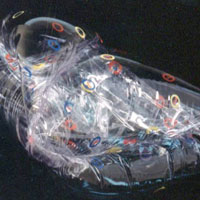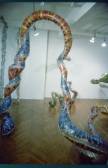| |
This work began at sunrise in July, l973, the vast smooth sandscape of Maine's Popham Beach (Fig. 1) inviting the inscription of a spiral. Wondering how to begin brought the realization that "the spiral" was a loosely used metaphor about which I knew very little. After returning to Ohio I made some large, simple inflatable forms that engendered an awe of its majical properties and their implication for three dimensional form. Years later I am cognizant of the seminal role that the spiral, as a mechanism, plays in the processes of the universe and especially in the generation, proliferation and differentiation of biological forms (See also Fig. 2: Archimedes Excursion, 1974).
The effect of the spiral is so vast that its exploration necessarily and naturally breaks into related yet discrete parts. For me the first of these to have more than a passing likeness to the processes of DNA was the series of works that was summarized in Anolatabulata l975-79, an exhibition at the Bertha Urdang Gallery, New York in l979 (Fig. 3). In these the working method was to subdivide two discs into four by inscribing yin-yang across the diameter. This produced four similar shaped pieces that could be reassembled as either four identical shapes, two mirror pairs, or three identical plus one mirror. In order to limit the inherently unlimited forms that could result limits were placed on the permutative process. This was done by always beginning and ending each match at one of four equidistant spots on the circumference of the individual parts. In spite of the restriction the method was prolific producing a family of 59 morphologically distinct shapes which broke down into six main sub-groups. Ultimately it was found that these works could be displayed in a spatial array that placed each "creature" between its nearest "relatives". The visualization of this was an approximately 108" x 54" flexible vinyl sheet upon which each form was represented in position on one of two equilateral triangles. These triangles when cut and assembled as a paired Zeemans Dunce Cap became a model for the time when space and curatorial insight will allow the whole array to be set in full scale three dimensionality (Fig. 4).
Closely following, and to some extent interspersed with the tear-drop-like shapes of the "Anolatabulata", was a sequence entitled Con(jug)ate in which the topological options were further simplified. This resulted in a study of the active symmetry that is inherent to the matching of like pairs. For instance matching congruent pairs of asymmetrical shapes, as for instance Con(jug)ate 4, will give a sequence of discretely different shapes whereas mirror matching the same shape gives a sequence of individual forms followed by a sequence that looks the same (Fig. 5).
In about l977 I had made Open, the first work in a series that became subsumed under the title Universe (Fig. 6). Open,a large work, was comprised of congruently matched strings of the outer annuli of a concentrically divided circle. It was an additive process which developed a shape that, depending upon proportions and orientation, either resembled a convolvulus flower or the funnel of a tornado. The finished form became a practical model that illustrates how it is possible to feel closer to historical events than it is to events that are occurring in the space of lived time. Assuming oneself to be on its edge, reading up the form is like looking back across a selected historical sequence, whilst the rapidly expanding distance around the edge represents all the forms of experience available at any one time but which one cannot hope to participate in or even, perhaps, understand.
The second manipulation of the annuli was to mirror match them. These showed a) that the manner in which the two original circles collide determines the angle at which the resultant form projects into space b) that the details of its shape are dependent upon the ratio of the annuli's width to the radius of the originating disc and c) as in "Progressive Transformations" a continuously changing conjunction will at first form a spiralling tube that makes a helix of ever diminishing radius and then begins to construct a huge open surface somewhat similar to that formed in the congruent match. The studio work Untitled 1982 shows the spiralling tube and the beginnings of the expansion (Fig. 7). Speculation here led to thoughts about how the mass of the universe could be continually compacting, dispersing and compacting in several places at once like a never ending omni-galactic Fourth of July. The whole series was subsumed under the title Universe. In June, l992 in Kiev, many of the single experiments exhibited together under the title "St. Laurent's Bubble Chamber" a reference to the spiral track left by accelerated charged particles in a magnetic field as visualized in a triggered hydrogen bubble chamber.
While the colored radial marking that was introduced for the Universe series frequently elicited commentary that referred to DNA it was not until l983 that it occurred to me that in fact the geometry inherent in both kinds of Universe works i.e. the congruent matching and the mirror matching was the key to predicting the shape, and to developing differentiation and hence more elegance to the somewhat clunky Anolatabulata and Con(jug)ate forms. The first pieces, entitled Life Sculpture, l982 grew out of subdivisions in which the yin-yang tear drops had grown tails. These were followed by the fishy, human and birdlike forms of Gods Games (Fig. 8). Because the Anolatabulata and Cong(jug)ate sequences had established my sense of the appropriate structural rules there was no need to reveal all the variants; thus shapes were pursued for their visual appeal and humor.
Most recently, inspired by Gaudi, and by the interacting paired spirals in the figurative sculpture of Bernini and Michelangelo, the investigations have revolved around spiral cuts into the originating discs (see Fig. 9: Entrace to the Garden). Although the sculptural effect is hard to predict, the mechanism for these is basically similar to that of the Universe experiments and hence an opportunity for enhanced emphasis on developing the surface markings. Marking of the surface began in l981 as a necessary aid to the analysis that furthered development of formal complexity. Colored radial and concentric markings made a detailed map of the surface that allowed me to reconstruct the history of any finished piece. In a fanciful sense they are akin to genetically determined coloration and markings of flowers, birds and people.
My first eleven years were as a solitary child on a large, remote working farm in a culture in which even the most favored children were expected to be "seen but not heard". As the library of the one room school consisted of a small crate of books renewed three times a year a talent for reading was necessarily directed towards the weekly magazine for farmers. As a consequence I developed a capacity for inference and independent conclusions as well as a taste for information. This background, combined with the eventual understanding that, for me, knowledge is acquired by visualization and through procedure, presumably produced an artist "on the wonder" so to speak. And, especially because of an early dip into the mysteries of the early forms of experimental psychology, as I worked it seemed almost as interesting to look at the coterminous thought processes as it was to produce objects. It's always relatively easy to recount in a simplified and "structured-after-the-fact manner" the development of a body of objects. Categories reveal themselves and are disclosed as identities and as they exist in relationships. But cognitive order (and disorder) is revealed in daily actions, in which new insights rapidly relegate to obscurity those that previously seemed paramount.
In the earliest days I was elated with art as a process in which my logical thoughts, my imaginative capacity and my hands all worked together. Later, especially in the 70's stimulated by the developments in artificial intelligence and what at the time was called Cognitive Science, I spent a lot of time metaphorically parked in the far roof trusses of my studio watching what was going on below. From this position I learned, and recalled, that I came to realizations seemingly haphazardly. In fact most frequently a new form or idea was followed by several months of back-up work before my logical mind reached an understanding equal to the initial intuitively derived concept. I came to understand that what we call instinct is really an accumulation of experience parked in our brains that is not immediately accessible to conscious thought but which, given the right stimulus, is available for instant and correct collation into new forms and insights. You will surely note this to be a logic for "trusting my instincts". But, I can truly say that, through art I have learned something of the relationship between intuition, experimentation and deduction; I have become cognizant that only some aspects of thought are bound up in or can be revealed by language -- visual or verbal; and I have achieved an appreciation of the distinction between closed and open systems and of the integral relationships that exist between order and disorder.
Most importantly, as the processes of art have instructed me, they have constructed a highly personalized model that is used daily to sort out and interpret new information. Simultaneously the principal mechanisms -- the whole cell matched in pairs, direct process, permuted but simple processes creating diversity, integrity of procedure, and the families of structures and the spiral which inevitably develop -- are a expressive metaphor for the energy, intelligence, sensuality, fecundity and determination of the thing we perceive as Life.
Betty Collings, September l993.
|
|
 |
| (1) Popham Beach (1973). |
| |
 |
| (2) Archimedes Excursion (1974). App. 10'x40'x10'. Vinyl. |
| |
 |
| (3) Anolatabulata (l975-79). Detail of Urdang Exhibition 1979. |
| |
 |
| (4) Zeeman's Dunce Cap (1979). App. 18"x18"x18". Vinyl ink on vinyl. |
| |
 |
| (5) Section from Con(jug)ate 4 (1977). Inflated vinyl. |
| |
 |
| (6) Open multiples with drawings. Urdang Gallery. (1979). Vinyl. |
| |
 |
| (7) Untitled 1982. Studio view. Vinyl ink on vinyl. |
| |
 |
| (8) Blowfish (1987-89). 40"x24"x24". Resin over acrylic on vinyl. |
| |
 |
| (9) Entrance to the Garden (1989). Resin over acrylic-painted vinyl. 102"x72"x54". |
| |
|
|